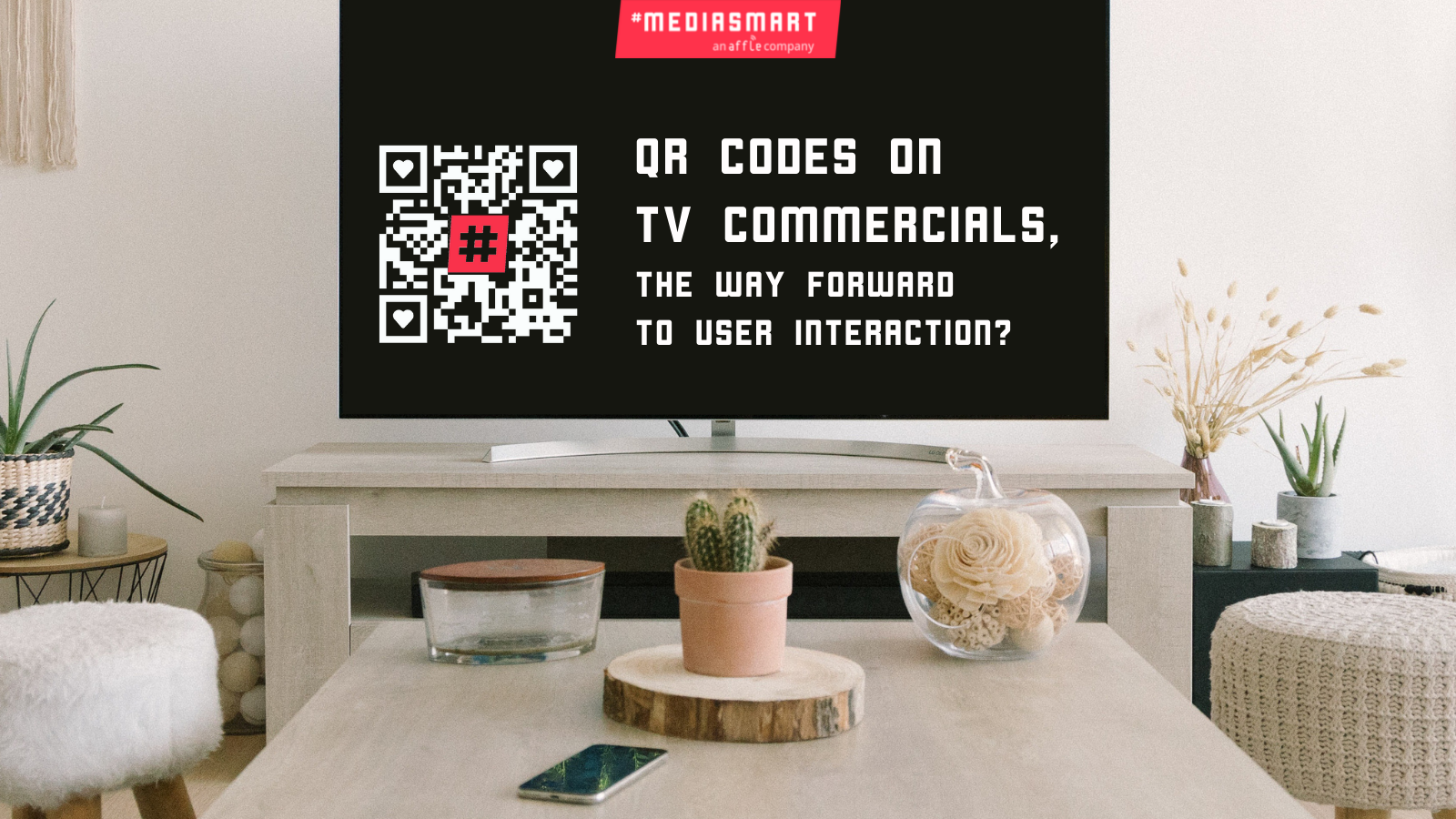Blog
Announcements, analysis and opinions on industry trends around the mobile programmatic world.

Subscribe now, and receive the latest programmatic content directly on your inbox!
Thank you for subscribing to our newsletter
Some have proclaimed that 2022 is the year of QR codes. The pandemic has made Quick Response (QR) codes not only very widely available but also frequently scanned across the globe, even on unexpected mediums such as the TV. The question that arises is: should you include QR codes on your TV or Connected TV commercials? Let’s explore the merit of such a strategy, through the Coinbase Superbowl example and then through more generic considerations.
Coinabases’s QR code: a true success?
Right now, the most famous case of a brand using a QR code on television is without a doubt the Coinbase commercial on the Superbowl, which imitated a screensaver and had a QR code that changed colours jumping on the screen all by itself. 60 full seconds of it. Nothing else.
Did you like it? And, more importantly, would you have scanned the code? Is it worth it as a marketing strategy? We have mixed opinions.
Starting with the bright side, the QR code was scanned so many times that their landing page crashed. In more concrete numbers, the Superbowl 2022 had 208 million estimated viewers and Coinbase’s landing page got 20 million views at the time of the commercial according to Bitcoin Magazine. This would represent a 10% interaction rate, for a 14 million USD estimated spend; so each interaction would have come at a cost of 0.7USD. Is that cheap or expensive? We cannot judge, as it depends on the brand’s track record.
Ignoring the crashing issue (which undoubtedly had bad repercussions for the brand’s image and limited the success of the marketing action itself), the commercial didn’t have any other element or explanation. Just a screen at the end with the brand name in the ’90s style. As shown by the CNN report on the Coinbase commercial, people had fun but also had trouble to scan the code. The impact and understanding of the offered product were limited, as many users did not access the offer. If we analyze its welcome, it didn’t even make it to the top 10 on the Ad Meter by USA Today, from the 64 ads that were shown overall during the match. The 150 000 panelists that evaluated the ads weren’t impressed by Coinbase’s efforts.
And, then, by adding the scanning component to the ad, it is digital advertising we are talking about. Was it possible to retarget those users that scanned the code, but more importantly those that scanned but couldn’t get to the offer? With the correct use of cookies, audiences and gathering of the consent of the end user, we expect the brand to have been able to retarget the first group. As for the second group, they are pretty much lost. And those are the ones we would expect the brand to want to retarget most, right?
All in all, it is undoubtedly creative as communication means, but with a limited user experience for the ones that weren’t able to scan the code and the ones that were but didn’t get to the landing; and all of it with one of the highest recorded investments in TV Advertising history. Is this a replicable strategy that can be used by any brand? Do QR codes usually get such an overwhelming interaction?
QR codes: the hassle of scanning
QR codes are far from being new technology. The first Quick Response - QR code was launched in 1994 by Denso Wave for their manufacturers as a response to the limited information stored on barcodes, which was 20 alphanumeric characters. So how come it has taken so long for the technology to be so widespread?
In our opinion, it is mainly due to the lack of familiarity with the technology, especially amongst kids and the elderly. I can’t have the reflex of scanning a code if I do not know that I have the possibility and the ability to do so. On top of that, there has been also a lack of native scanning tools on smartphones. Direct or native QR scanning from the smartphone camera is a relatively new advancement; as is, by the way, having an internet connection on phones.
According to the QR Codes forecast and trends 2022 by Insider Intelligence, 83 million smartphone users scan QR codes in the USA and the number will increase by 20% to 99.5 million in 2025. A survey conducted in Spain, France, Germany, the Netherlands, the United Kingdom and the United States found that 83% stated they used a QR code to make a payment for the first time ever since the pandemic started.
QR codes are very versatile, an organization can link a number of things to those small codes from ‘simply’ directing customers to a landing page, to sending a message in real-time (say using WhatsApp), downloading an app, directions to a particular business location, displaying social media profiles or directly a shopping experience by giving direct access to the brand’s eCommerce. There is no question that this technology is here to stay. But, let’s explore it applied to advertising on television.
In the ideal user journey, the following steps must happen:
- First, there is a commercial that includes a QR code.
- You have your phone at hand and either isn’t doing anything in particular with it or you are doing something you can stop without previous notice.
- You are interested in the product, you see a QR code that is big enough to be easily scanned. You open your camera or an app to scan the code.
- In the best-case scenario, you have a native QR reader on your phone’s camera that opens fast, but you will have to wait about one or two seconds so that the QR is recognized.
- The camera reads it on the first try.
- Then, the scan after a couple of seconds will bring you to a landing page or the app store.
- You get to the information that the advertiser wanted you to have and might - or not - take action (like filling out a form, downloading an app, etc.).
It’s clear that there are several steps along the way where things could go awry. What happens if the QR code is not big enough to be recognized? What if the TV is far and the brightness is low or if the QR code disappears mid-scan because you weren’t fast enough to scan it? What if you need to launch a QR reader app before scanning the code? And what if the scanning goes wrong and the intended destination doesn’t load fully? Most assuredly, you - as the end user - won’t get the offer or the information and the whole marketing action will have lost its key impact.
On top of that, there is the configuration of the QR code to be taken into account. There are static - where tracking cannot happen and they lead to a single destination - and dynamic QR codes. A correct set-up by the advertiser would use Dynamic QR codes to gain the ability to edit the URLs and to track the number of scans, the location, and the times it was scanned. All things considered, the process is not exactly a walk in the park both for advertisers and the targeted segments.
The interactive alternative: Household sync
Is there an easier way to advertise and generate interaction with customers? Yes.
Mediasmart’s Household sync is a technology that allows advertisers to increase brand impact by syncing ads on Connected TV (CTV) with ads on other devices in a household.
Serving high-impact ads on CTV and giving users the possibility to interact with the ad on their phone will generate a sophisticated brand experience and also make the ROI of any campaign more measurable, as the chances to attribute conversions (leads, purchases, visits to store, etc.) to a campaign, to know the origin of a conversion, exponentially increase.
The set-up couldn’t be easier:
- A commercial or TV spot is served on the Connected TV (any TV connected to the internet either a smart TV, a set-up box, an OTT, or a dongle).
- Mediasmart’s Household sync technology will find users within the same household and serve an ad within the timeframe (between the 30s and 10 days after serving the CTV ad) chosen by the advertiser.
No fumbling to get to the phone, nor to open the camera. No QR code disappearing from the screen or having a static QR code on screen forever. What is more important: no effort whatsoever on the users’ part. Add to that the full capabilities of both CTV and mobile advertising. Sounds magical, right? It’s not sci-fi, just state-of-the-art technology.
And, what about results? Please, bear in mind that pricing of both mobile and CTV advertising will vary greatly depending not only on the geo of the ad, but also on the publishers being used, so it is hard to make a realistic approximation to the number of ads an advertiser would need to reach the 20 million interactions that were generated by the Coinbase Superbowl ad using ConnectedTV and Household sync.
To simplify let’s make an approximation just on the mobile side of things. An equivalent campaign with an average of 2% CTR, would mean an advertiser needs 1 billion mobile impressions to get to 20 million interactions. Let’s say the average CPM of the mobile part is 2$ USD, and the price for the interaction on mobile would be 2 million USD, which would have left ample budget for Coinbase to do branding strategies on CTV... Household sync looks like a tactic that might have brought a better return on investment.
By connecting devices in the same household, Household sync makes ads more personalized for specific audiences while bringing together the twin strengths of the engaging storytelling associated with advertising on television and the targeting and measuring capabilities of programmatic marketing.
QR codes are popular for good reason, as they are a great way to get information to interested people who are willing and able to scan them. Although there are smart ways of integrating QR codes into your (C)TV ads, far from being the future of TV advertising, we think that QR codes in TV ads are a passing trend. Why? They were designed expecting end users to take action, to make the first move. Although we expect QR codes will give space to solutions that generate a seamless user experience, like Household sync, with minimum effort on the end user’s side. We are prepared not only to handle CTV creatives that include QR codes but also to measure their effectiveness through scanning rates thanks to our MMP partners, like Adjust.
Mediasmart’s end goal is to make CTV ads better for advertisers. Any advertiser’s goal, in the end, is to find the most convenient way for the users to interact with them. Find which solution: QR scanning or Household sync works best for your brand by buying Connected TV ads through mediasmart’s omnichannel programmatic platform. Start today!
Topics: connected tv, CTV, 2022, Innovation, QR codes on CTV, QR codes


